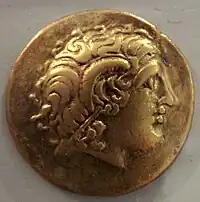The Vergunni were a Gallic tribe dwelling in the valley of the Riou, near the Verdon river, during the Iron Age.
Name
They are mentioned as Vergunni by Pliny (1st c. AD) and on an inscription.[1][2]
The meaning of the name remains obscure. It could be derived from the Gaulish stem uergo- (cf. Gaul. uergo-bretus 'magistrate', OBret. guerg 'efficax', Welsh gwery 'active', OIr. ferg 'anger').[3]
The village of Vergons, attested as villa Virgonis in 814, is probably named after the Gallic tribe.[4][3]
Geography
The Vergunni lived in a small piece of land situated in the valley of the Riou, a stream tributary of the Verdon river.[4] Their territory was located north of the Suetrii, east of the Sentii, south of the Eguiturii and Nemeturii, and west of the Ecdinii, Vesubiani and Nerusii.[5]
History
They are mentioned by Pliny the Elder as one of the Alpine tribes conquered by Rome in 16–15 BC, and whose name was engraved on the Tropaeum Alpium.[6]
References
- ↑ Pliny. Naturalis Historia, 3:20; CIL 5:7817.
- ↑ Falileyev 2010, s.v. Vergunni.
- 1 2 Delamarre 2003, p. 315.
- 1 2 Barruol 1969, pp. 379–380.
- ↑ Talbert 2000, Map 16: Col. Forum Iulii-Albingaunum.
- ↑ Pliny. Naturalis Historia, 3:20.
Primary sources
Bibliography
- Barruol, Guy (1969). Les Peuples préromains du Sud-Est de la Gaule: étude de géographie historique. E. de Boccard. OCLC 3279201.
- Delamarre, Xavier (2003). Dictionnaire de la langue gauloise: Une approche linguistique du vieux-celtique continental. Errance. ISBN 9782877723695.
- Falileyev, Alexander (2010). Dictionary of Continental Celtic Place-names: A Celtic Companion to the Barrington Atlas of the Greek and Roman World. CMCS. ISBN 978-0955718236.
- Talbert, Richard J. A. (2000). Barrington Atlas of the Greek and Roman World. Princeton University Press. ISBN 978-0691031699.
